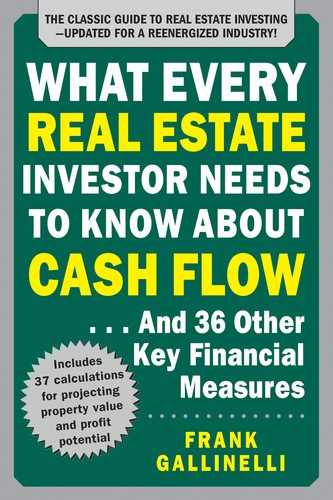CHAPTER 30
Calculation 24: Break-Even Ratio
What It Means
You should know about the break-even ratio (BER, also sometimes called the default ratio) because it is a benchmark often used by lenders when underwriting commercial mortgages. Its purpose is to estimate how vulnerable a property is to defaulting on its debt should rental income decline. There is an old saying that when your outgo exceeds your income, your upkeep will be your downfall. Essentially, the lender is trying to gauge the proportion between your outgo and your income, so as not to share in that downfall.
You should review debt coverage ratio (another major benchmark favored by lenders) in the previous chapter and loan-to-value ratio in Part II, Calculation 26.
How to Calculate
Break-Even Ratio = (Debt Service + Operating Expenses) / Gross Operating
Income
Example
You expect first-year operating expenses of $22,000 and annual debt service of $24,000. If your gross operating income is $57,500, what is your property’s BER?
Break-Even Ratio = (Debt Service + Operating Expenses) / Gross Operating
Income
Break-Even Ratio = (24,000 + 22,000) / 57,500
Break-Even Ratio = 80%
Test Your Understanding
1. Your property has 12 units that rent for $1,200 each. Your vacancy and credit loss is 7%; operating expenses average $6,700 per month; debt service is $5,350 per month. What is the property’s BER? Will it satisfy the typical lender described in the Rule of Thumb above?
2. You have a property with debt service of $2,500 per month. Annual operating expenses are $28,000. What GOI must you have in order to satisfy your lender’s requirement for a BER of 85%?
Answer
1. You need to start by calculating the GOI.
Gross Scheduled Income
less Vacancy and Credit Loss
= Gross Operating Income
You have 12 units at $1,200 for 12 months, so gross scheduled income and vacancy at 7% are as follows:
Gross Scheduled Income = 12 × 1,200 × 12 = 172,800
Vacancy and Credit = 172,800 × 0.07 = 12,096
Now you calculate the GOI:

To figure the BER, you’ll need to convert operating expenses and debt service to annual amounts:
Operating Expenses = 6,700 × 12 = 80,400
Annual Debt Service = 5,350 × 12 = 64,200
Finally, apply the BER formula:
Break-Even Ratio = (Debt Service + Operating Expenses) / Gross Operating
Income
Break-Even Ratio = (64,200 + 80,400) / 160,704
Break-Even Ratio = 90%
The lender described in the Rule of Thumb will probably have doubts about this property’s ability to meet its obligations should it face an increase in vacancy.
2. Start by applying Algebra 101 to transpose the formula:
Gross Operating Income = (Debt Service + Operating Expenses) / Break-Even
Ratio
Gross Operating Income = [(2,500 × 12) + 28,000] / 0.85
Gross Operating Income = 58,000 / 0.85
Gross Operating Income = 68,235
